Omaha class cruisers (1920)
 USA (1920-24)
USA (1920-24)
USS Omaha, Milwaukee, Cincinnati, Raleigh, Detroit, Richmond, Concord, Trenton, Marblehead, Memphis
The new kids on the block
The Omaha were the first American cruisers after a very long eclipse dating back to 1907 (the Chester). They were originally designed in 1919, originally to bring the squadrons of large-scale destroyers (Wickes and Clemson classes) from the end of the Great War. Like them, they had this typical flush-deck and four funnels.
Almost scaled-up versions used as destroyer leaders. In addition their artillery was quite original, with an arrangement of two twin turrets and fore and aft barbettes, an unlikely mix that illustrated their transitional nature. They were launched in 1920-23 completed in 1922-24, bearing the names of mostly southern American cities (Omaha, Milwaukee, Cincinnati, Raleigh, Detroit, Richmond, Concord, Trenton, Marblehead, and Memphis).
Built lightly, they relied on speed and were part of this generation so-called “tin-clad cruisers”, relying on speed as their only protection at a time rangefinder still lacked precision for fast-moving targets. However they were somewhat heavy and particularly wet in heavy weather in the North Atlantic/ They quickly acquired such reputation that sailors used to joke that their machines did not run on oil but with Atlantic seawater. These cruisers had a long career, being modernized and spent all the inter-war on various stations and still be very active in world war two, the class avoiding a single loss in service.
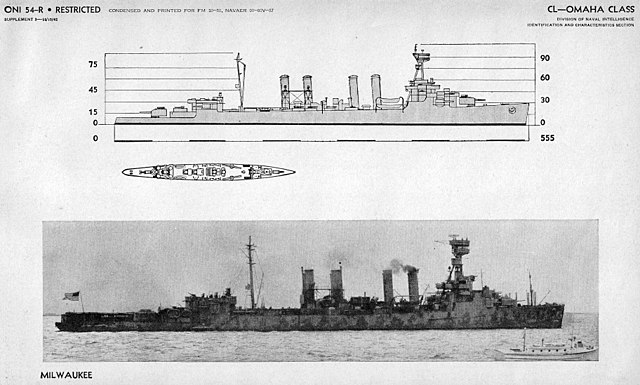
Omaha class drawing, and an example of early 1942 camouflage
Genesis and design
The Omaha class was first envisioned in 1915 when it was clear that the US Atlantic Fleet lacked fast cruisers needed for scouting and at the same time deny enemy cruisers access to intelligence on the fleet or screen friendly forces. At that time, the Chesters were already 8 years old and were not enough in numbers compared to the massive battleships construction plans.
The first specifications called for high speed (35 kn (65 km/h; 40 mph)) to lead and cooperate with destroyers, and having the firepower to over-match them as well. Oddly enough, UK was considered a possible (if very improbable) enemy on the Atlantic, and the team responsible for the design carefully studied the British Centaur, a subclass of the prolific C-class cruiser.
When the final blueprints were approved in 1918, their resemblance with the Clemson class destroyers was considered a possible way to cheat the enemy, a bit like a “Q-ship”, to conceal its real firepower, and plans were even made to apply the very same camouflage patterns used on these destroyers, at larger scale.
Armament
In the end, these 7,000 tons ships sacrificed a lot to speed, and bear an armament spread between fore and aft standard turrets (the first for this caliber, but also adopted on the British Enterprise) the remainder eight of the twelve 6-inch/53 caliber guns being placed in casemates, four on each side located in upper and lower casemates.
These 6-in guns were brand new, and first appeared on this class: The 6 inch x 53 caliber was equivalent to 8 meters and each gun side had swing Welin breech block and Smith-Asbury mechanism weighed. Each one was about 10 tonnes using silk bags containing 44-pounds (20 kg) of smokeless powder. They were loaded with 105-pound (47.6 kg) projectile and fired at 3000 feet per second (900 m/s) muzzle velocity.
This traduced by a maximum range of about 21,000 yd (19,200 m) at 20 degrees elevation maximum. The barrels were built-up with a liner, tube, full-length jacket, and 2 hoops and its life expectancy was about 700 effective full charges (EFC) per liner. These guns were particular as being fitted in the new Mark 13 casemate mounting designed for the Omaha class, the primary battery also intended for the secondary battery of the never-completed Lexington-class battle cruisers and South Dakota-class battleships.
Secondary armament comprised two 3 in (76 mm)/50 caliber anti-aircraft guns. The standard Mark 3″/50 caliber guns (Marks 10, 17, 18, and 20) from 1915 were dual purpose, after initial Mk.2 going back to 1898 being anti-ship only, the low-angle Marks 3, 5, 6, and 19 were being mounted on small ships, auxiliaries and submarines.
These guns were true “quick-firing”, using fixed ammunition with powder case and projectile permanently attached. The shells weighed 13 poundes, with an explosive bursting charge of 0.81 pounds in AA configuration or 1.27 pounds for High Capacity, explosive means. Maximum range was 14,600 yards °45 in elevation up to 29,800 feet (9,100 m) in ceiling at 85°. The barrel’s life expectancy was 4300 EFC. Rate of fire was 15–20 rounds per minute at a muzzle velocity of 2,700 ft/s (820 m/s).
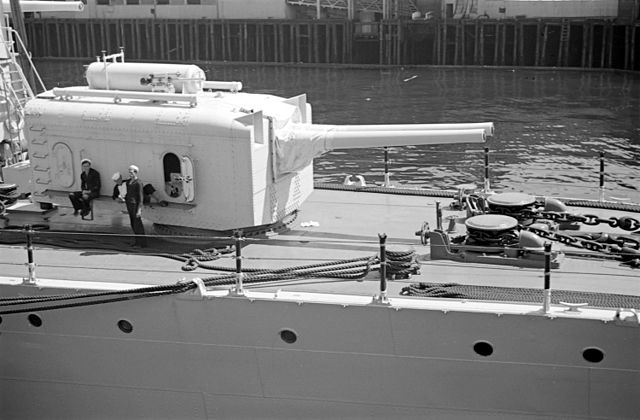
USS Cincinatti 6-in gun turrets closeup
There was also a set of ten torpedo tubes, spread into two triple and two twin 21 in (533 mm) torpedo tubes, with reloads. These could have been the recent Bliss-Leavitt Mark 8 torpedoes of 1911, surface models used on the Wickes Clemson classes and 1920s cruisers. Production of this model went on from 1913 to the interwar, many being still in service by WWII, especially on PT-boats.
Each weighed 2,600 pounds, was 256.3 inches (6.51 m) long for a diameter of 21 inches and a maximum firing range of 16,000 yards. They carried a warhead filled with TNT which weighed 466 pounds, exploding on contact. They were propelled by a turbine fed by a propellant combining Air (2800 psi, 23.4 cut), water (90 US pints or 43 l) or Alcohol (49 US pints or 23 l) up to 36 knots (65.1 km/h).
There were also rails, helped by the flush-decks, to carry up to 224 mines. However, after a few years of service and tests with these, Secretary of the Navy, Curtis D. Wilbur after receiving reports ordered the rails to be removed from all cruisers.
Later on, in 1933, the 3-inch AA guns were increased from two to eight while two lower torpedo tubes were removed and the openings welded shut. Still, for the same reasons in 1940, their lower aft 6-inch guns were removed and also plated over. In early 1942 they received also three quadruple 1.1-inch (28 mm)/75 gun mounts “Chicago Pianos”. Later they were removed and replaced by the standard Bofors 40mm guns while about fourteen single Oerlikons were installed.
Propulsion
Four shafts were connected to four Westinghouse reduction geared steam turbines, fed by 12 Yarrow boilers each working at 265 psi (1,830 kPa) for a total of 90,000 shp (67,000 kW). Top speed was 35 knots (65 km/h; 40 mph) with an endurance of 9,000 nmi (17,000 km; 10,000 mi) at 10 kn (19 km/h; 12 mph). However it was observed that sustained high-speed steaming can contaminate the oil tanks with sea water, because of leakages and the low freeboard causing water to be ingested through doors, vents, deck hatches, or torpedo and barbettes rear openings.
Protection
Poorly insulated, these cruisers were icy and wet in winter, but furnaces in summer under the tropics. Their anti-submarine protection was quite advanced however, but they lacked a full-length waterline armor belt. Their belt was 3 in (76 mm), the deck 1 1⁄2 in (38 mm), the conning Tower was 1 1⁄2 in and bulkheads were 1 1⁄2-3 in.
In fact the boilers, engine rooms and steering gear were not better protected than in a destroyer, but compartmentalization compensated for that. Indeed if the drawbacks of the cruisers were recognized, the ships featured for the first time improved ASW defence as the propulsion machinery was laid out on the unit system. This consisted in spreading alternating groups of boiler rooms and engine rooms. The goal was in case of a single torpedo hit, the flooding was kept limited and the ships can survive.
Their great speed was a match for submarines anyway. In fact, the cruisers were never used in their intended scouting role, which was taken by aircraft carriers, and were relegated to fleet-screening role, with better efficiency thnan destroyers due to their larger range and heavy firepower.
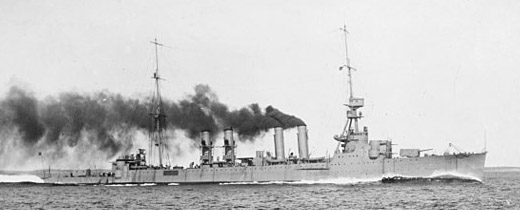
USS Richmond on trials May 11, 1923
The class comprised:
Strictly speaking, these cruisers are not placed in the WW1 section because of the date they were laid down, in December 1918 for the first two. The last one was commissioned in 1925.
USS Omaha (CL-4) was built at Todd Dry Dock & Construction Co., Tacoma, Washington, launched 14 December 1920 and commissioned 24 February 1923
USS Milwaukee (CL-5) was built at Todd Dry Dock & Construction Co., Tacoma, Washington, launched 24 March 1922 and commissioned 20 June 1923
USS Cincinnati (CL-6) was built at Todd Dry Dock & Construction Co., Tacoma, Washington, launched 23 May 1921, commissioned 1 January 1924
USS Raleigh (CL-7) was from Bethlehem Shipbuilding Corporation, Fore River Shipyard, Quincy, Massachusetts, launched 25 October 1922, comm. 6 February 1924
USS Detroit (CL-8) was from Bethlehem Shipbuilding Corporation, Fore River Shipyard, Quincy, Massachusetts, launched 29 June 1922, comm. 31 July 1923
USS Richmond (CL-9) was built at William Cramp & Sons, Philadelphia, launched 29 September 1921 and commissioned 2 July 1923
USS Concord (CL-10) same yard, launched 15 December 1921, commissioned 3 November 1923
USS Trenton (CL-11) same yard, launched 16 April 1923, commissioned 19 April 1924
USS Marblehead (CL-12) same yard, launched 9 October 1923, commissioned 8 September 1924
USS Memphis (CL-13) same yard, launched 17 April 1924, commissioned 4 February 1925
The Omaha class in the interwar
After 1925, the Navy started to have an idea of these ships in service and was not pleased with them. Already in 1918, there was an alternative design, which was dropped but looked more promising: This new class and height 6-inch guns in four turrets forward and aft, and there was another alternative version intended to function as a monitor with two 14-inch guns in 2 single turrets. The other design was given four 8-inch guns in two twin turrets but evolved later into the Pensacola-class cruiser.
These ten ships received in 1936 a new main telemeter, their front mast was reinforced, and a more modern AAA was added to them in 1939, consisting of several twin cal.50 (12.7 mm) machine gun mounts. In 1942, they were taken in hand for a reinforcement of their AAA, modernized notably with new 5-in (127 mm) guns and a very reinforced light armament (see specifications). Those sent to the Pacific as those assigned to the Atlantic served as escorts.
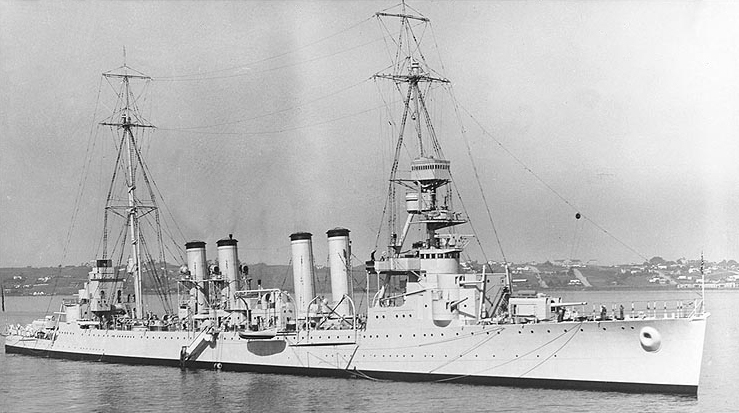
USS Marblehead, early 1930s
Characteristics (in 1942):
Displacement: 7050 t, 8950 T FL
Dimensions: 172 x 16,2 x 7,25 m
Propulsion: 2 propellers, 2 Westinghouse turbines, 2 BW boilers, 70,000 hp, 32 knots max.
Armour: Maximum 90 mm belt, 25-50 mm blockhouse, bridges and reduced.
Armament: 10 x 152 mm (2×2, 6×1), 6 x 127 mm, 2 quadruple 40 mm, 8 x 20 mm oerlikon, 8 x 12.7 mm HMG, 2×4 TT 533 mm.
Crew: 750

USS Milwaukee in june 1942, on her way to guadalcanal.
Sources/read More
en.wikipedia.org/wiki/Omaha-class_cruiser
http://pwencycl.kgbudge.com/O/m/Omaha_class.htm
ONI Drawings http://www.coatneyhistory.com/drawings.htm
http://www.ibiblio.org/hyperwar/USN/ref/ONI/ONI-54/ONI-54-R-Sup4/ONI-54-R-Sup4.pdf
https://upload.wikimedia.org/wikipedia/commons/6/64/Omaha_class_cruiser_drawing.jpg
http://lcoat.tripod.com/shipdraw.htm
http://www.avalanchepress.com/OmahaAlternatives.php
http://www.navypedia.org/ships/usa/us_cr_omaha.htm
Conway’s all the world fighting ships 1906-1921
The Omaha in action during ww2
At min-1942 a radar was added to them, and what was left of torpedo tubes (four quadruple banks, originally 16 tubes) were removed to improve their stability, as well as catapults for float planes. In 1944, the Milwaukee was transferred to the USSR as a lend-lease becoming the Murmansk, to provide escorts from that port. None of these cruisers were sunk during the war. They were all scrapped in 1946, except the Murmansk, returned in 1947.
 USS Omaha
USS Omaha
After a career without surprise or notable event, in 1937 Omaha became grounded on a reef at Castle Island, Bahamas. After repairs at Norfolk Navy Yard, Portsmouth, Virginia, the ship sailed to Gibraltar on 30 March 1938, and served in the Mediterranean Sea until May 1939. The war broke up when she was undergoing extensive overhaul from 17 June until October 1939.
She then operated in the Caribbean and was based in Lisbon to protect US citizens interests and relieve the ships which had done so after the Spanish civil war. She also sailed to Liberia, then was back to Pernambuco, Brazil, and the Caribbean, then Brooklyn for a refit. With two of ther sister-ships she began “neutrality patrols” between Brazil and Ascension Island. USS Omaha enforces the German blocus, by intercepting, boarding, and inspecting vessels as potential German merchants or hosting agents.
She patrolled along South American lanes and afterward searched for German blockade runners. In particular, she intercepted a seemingly american freighter named Willmoto in November, 6, 1941, which revealed after inspection to be the German Odenwald, that her crew was prepared to scuttle.
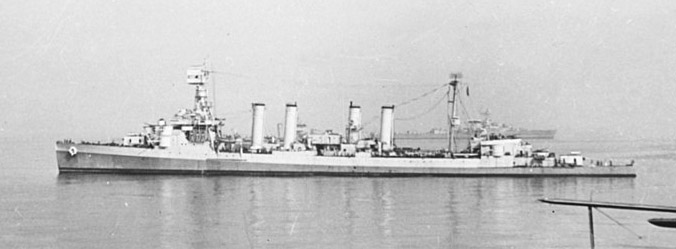
When the Pearl Harbor attack erupted, she was to “execute WPL (war plan) 46 (Rainbow 5) against Japan.” but the Omaha did not joined the Pacific theater and went on with Atlantic patrols against U-boats, taking a deliberately more agressive stance and rescuing crews of many sunken ships in the area, Lammot Du Pont, and Charlbury (sunk by an Italian submarine), Harpagon, Rio Diamante, and several Brazilian merchantmen.
On 30 April 1943,she collided with USS Milwaukee during manoeuvers at high speed, the latter hitting her starboard bow, and she was repaired in Rio de Janeiro for the at the Brazilian Navy Yard. She later rescued off the same coast the merchantman Rio Grande and sank the armed German blockade runner Burgenland and rescued the U-177 survivors.
In July 1944 she was transferred to Malta, and in August participated in Operation Dragoon, the Provence landings, dealing with German shore batteries. In September she was back in southern Atlantic, operated with the Brazilian Navy from then on, and in December she underwent her last refit at the New York Navy Yard. She searched for survivors of the sunken Brazilian cruiser Baia, from Recife, on 8 July 1945. After the war ended she was decommissioned on 1 November 1945, stricken and scrapped in 1946.
 USS Milwaukee
USS Milwaukee
It’s worth noticing than the USS Milwaukee while en route to Australia after a shakedown cruise, carried depth–finding equipment and surveyed the floor of the Pacific, making some underwater discoveries like the peaks called Milwaukee Seamounts in 1929.
She collided with USS Detroit in Guantanamo Bay (Cuba) on 1926, but without gravity, served with the Asiatic Fleet in 1928, returned home but was back in the Western Pacific after the Panay Incident in December 1937. With the same equipment described above she also found in 1939 the deepest Atlantic depression, the “Milwaukee Deep”.She took part in neutrality patrols, and was overhauled at the Brooklyn Navy Yard when the war broke out with Japan.
She operated then in the Caribbeans, and later escorted convoys between Brazil and the African coast, rescuing survivors of sunken freighter, trying to spot and destroyer submarines and German blockade runners. In November 1942 she intercepted the Anneliese Essberger. She went on with the same duties in 1943 but eventually collided in May 1943 with USS Omaha collided off the coast of Brazil, and was sent to repairs in Brooklyn.
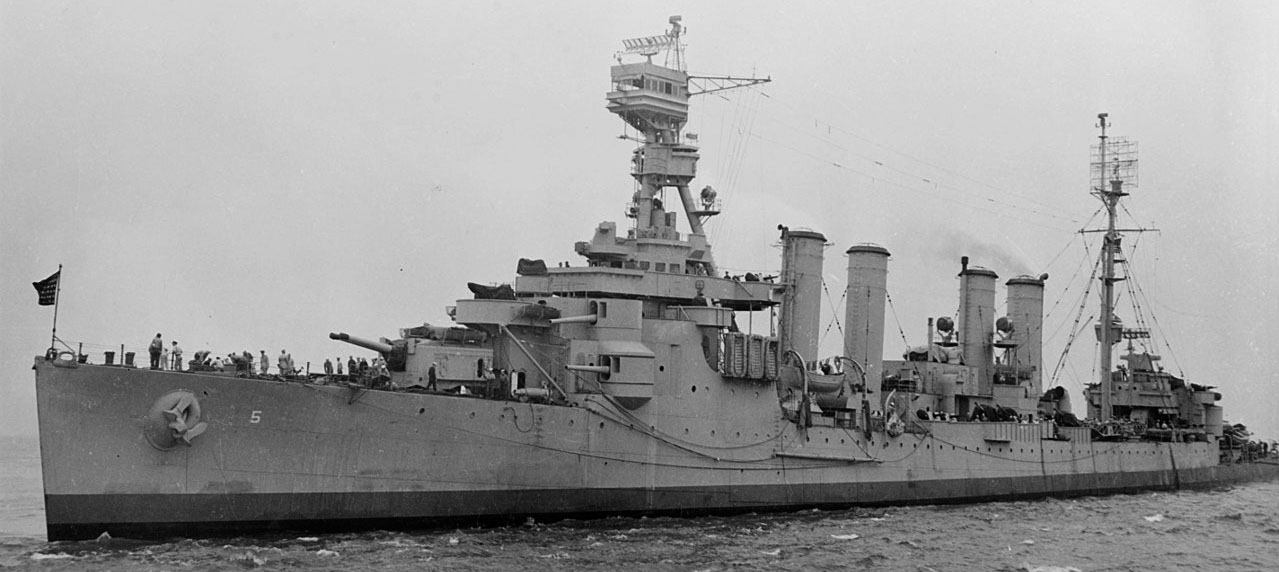
USS Milwaukee off New York August 1943
She was the only cruiser of her class temporary transferred to the Soviet Union, replacing actual Italian ships being granted as war damage after the Italian surrender and escorted a convoy to Belfast on 8 March and then took part of the Convoy JW 58 vound to Murmansk on 29 March.
Upon arrival on 20 April, she was transferred on loan to the Soviet Northern Fleet, based in Murmansk and commissioned with the same name “Murmansk” performing numerous Arctic Ocean patrols and escorts until the end of the war, and afterwards became a training ship, taking part in the 1948 fleet maneuvers, transferred in 1949 back to the US and she was in Philadelphia Naval Shipyard on March 1949 when the commission decided to sold her for scrapping on December.
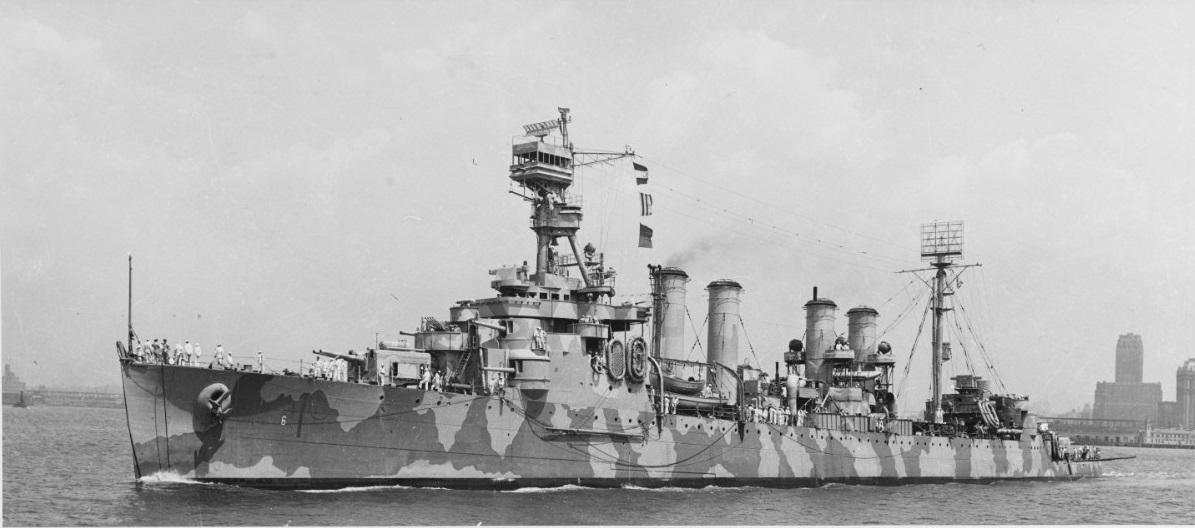
 USS Cincinatti
USS Cincinatti
Cincinnati was at first part of the Scout Fleet of the eastern seaboard and the Caribbean until 1927, and operated in the Far East (From Shanghai) until 1928. She was back home and operated from then in Rhode Island and the east coast until 1932. She was back and forth in the Pacific squadron and the east coast until 1939, and with the war, join the Atlantic for neutrality patrols.
She transferred to Pearl Harbor in April 1940, for escort duties, spending a year there before being transferred in the Pacific, and then returned to the Atlantic for expanded neutrality patrols in the western Atlantic. She also performed convoy escorts, took part in the French Fleet blockade at Martinique, searched for German blockade runners.
On 21 November 1942 she intercepted with two other ships the Anneliese Essberger sending a boarding party to captured the crew before she sank. After an overhaul at New York in 1944 she escorted convoys from New York to Belfast, until July 1944 sailed for the western Mediterranean to take part in the Provence landings, then back to New York for a last overhaul. Until the end of the war she was part of the 4th Fleet at Recife, Brazil to patrol south Atlantic shipping lanes until decommission in November 1945.

USS cincinatti off NY City 22 March 1944
USS Raleigh
She was part of the light Cruiser Division, Scouting Fleet operating in northern European waters with the Army Air Service’s World Flight, performing the first aerial circumnavigation of the world. in 1924-1925 she operated from Virginia Capes, doing fleet exercizes off Panama, California, and the Hawaiian Islands. She carried Marines for a simulated assault in Guantánamo Bay, Cuba, and policing operations in Nicaragua.
She then took part in Atlantic coastal operations until 1928, then operated from the West coast, and after the start of the Spanish civil war was sent in Spanish waters to evacuate American nationals from threatened areas. She was also based in Villefranche on 28 April 1938, and then back to San Diego from where she operated and later sailed to Hawaii until December 1941. By then she was moored at berth F-12, east side of the north channel. She was struck by a torpedo listed but did not sank thanks to her ASW protection and her gunners helped to down five Japanese planes.
After repairs she departed on 21 February 1942 as an escort bound to San Francisco. She then sailed to Pago Pago on 3 November to look for Japanese picket boats, then was back to Pearl Harbor and from there, sailed to Dutch Harbor, Unalaska, Aleutians for the campaign to prevent Japanese occupation of these strategic but desolated northern islands. She was part of the Task Group 8.6 (TG 8.6) covering the occupation of Amchitka Island, and Kiska, then Attu. She also shelled Japanese installations at Paramushiru in the Northern Kuriles. Back home, she joined the Atlantic squadron in 1945 and operated there until decommission.
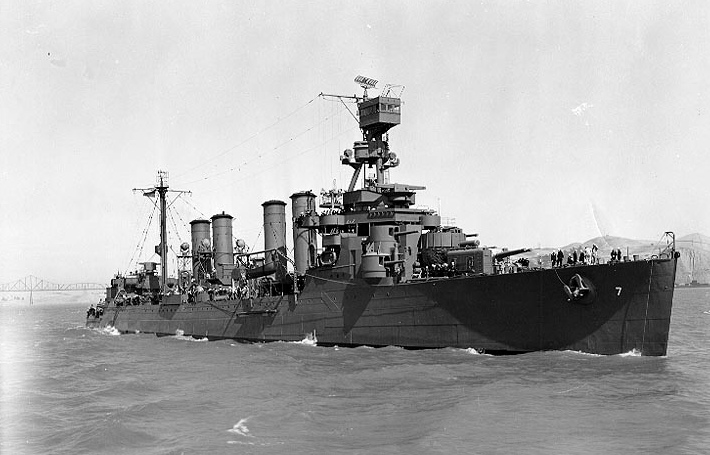
USS raleigh off Mare island Arsenal 6 july 1942.
 USS Detroit
USS Detroit
Built in Quincy, Massachusetts like her sister-ship Raleigh, the USS Detroit make her shakedown cruise to the Mediterranean and then operated from 1927 from Boston and off the east coast in 1926, Nicaragua in 1927 and the next year toured Europe North Africa, and the Middle East, in goodwill visits to various ports and then back to Norfolk, Virginia on 12 September 1928, operating on the east coast until 1931.
Then she was sent to the West coast, operating from San Diego, California in 1931, taking part in maneuvers in Alaskan and Hawaiian waters until 1934. She participated in manoeuvers from San Diego from then until 1941 where she was sent to Pearl harbor. When the attack took place in December 1941 but she was able to get underway, safely downing several aircraft with a dense anti-aircraft fire, one of her crew receiving the Purple Heart. She later joined the cruisers Phoenix and St. Louis and two destroyers to investigate any possible IJN landing at Oahu.
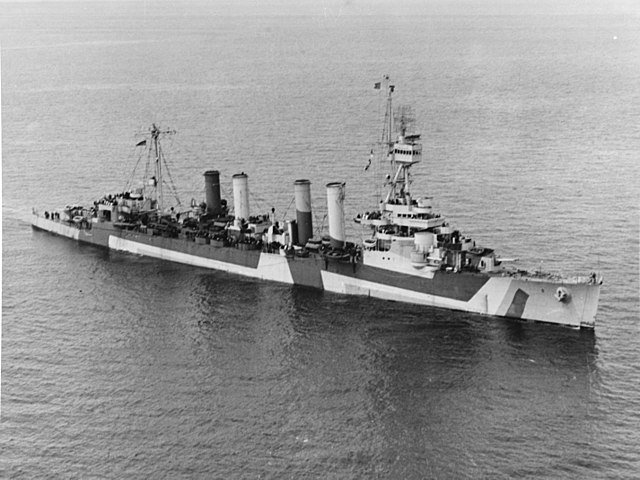
USS Detroit off port Angeles, Washigton state, April, 14, 1944.
She then took part in Convoy escorts between her home port and the West coast, and from November 1942 she sailed for Kodiak, Alaska, and became a flagship for the Task Group 8.6 (TG 8.6), that took part in the Aleutian islands campaign. She covered the operations against the Japanese garrisons on Kiska and Attu and remained in Alaskan waters until 1944. From August, she served as temporary flagship of the Southeast Pacific Force, and from January 1945, sailed to Ulithi and from there the 5th Fleet. She was present for the surrender in Tokyo Bay on 1 September, and was decomissioned back home and scrapped.
 USS Richmond
USS Richmond
For her first cruise in 1922 she toured Europe, Africa, and South America, and was based in New Orleans from 1932. She took part in the navy’s aerial circumnavigation, took part in manoeuvers in the Caribbeans in 1925, and was sent in Hawaii for joint Army-Navy maneuvers, and then made a good will cruise to Australia and New Zealand the same year, then back to Norfolk. She toured China, arriving at Shanghai on 3 April 1926, and in 1928 departed San Pedro, California, for Corinto, Nicaragua, landing marines.
From September 1934 to December 1937, she was in the scouting fleet west coast, and rescued in 1935 the crew of the downed airship USS Macon. She was back on the East coast in 1938, and by December 1940, was the flagship of an Atlantic Submarine Force. She was then sent in 1941 to Richmond and sailed for Pearl Harbor but on December, she was en route to Valparaíso, Chile. She then patrolled the waters of Panama in 1942 and made convoys escorts to the Galápagos Islands and the Society Islands and then the South American lanes.
By 1943 she was sent in the Aleutian waters. he participated in the operations against the IJN at Holtz Bay and Attu Island then Attu and Kiska. In March she took part in the Battle of the Komandorski Islands. She by then covered landings at Attu and later Kiska. She want back home for an overhauled but returned in Alaskan waters until the end of the war.
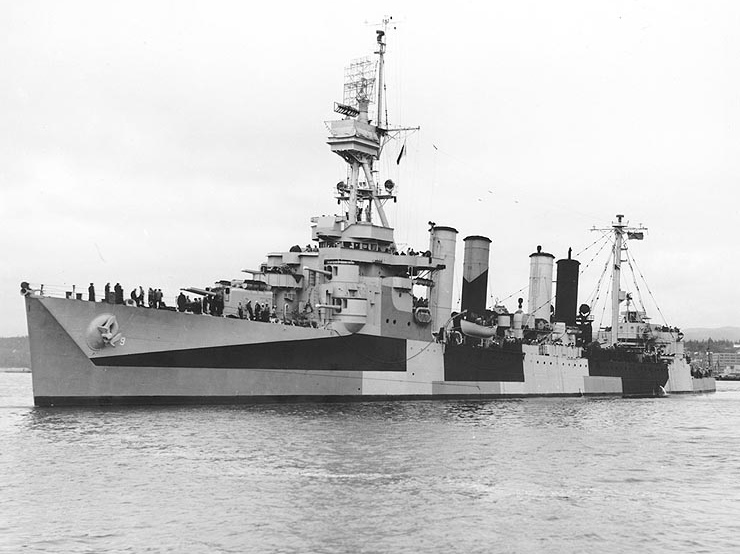
USS Richmond off Puget Sound NYd, Bremerton, Washington, 24 June 1944 showing her port side Measure 32, Design 3d camouflage.
 USS Concord
USS Concord
Her shakedown cruise was in Mediterranean ports. She operated in the Caribbeans, Hawaiian Islands in 1924–1925 and back in the Atlantic for a fleet review in 1927. In 1932 she was in the Cruiser Division 3 Battle Force, at San Diego. She rescued part of the USS Macon airship crew, and after another naval review (this time for President Roosevelt) she was from 1938 deployed in the Hawaiian area, the Panama Canal, and off Alaska. On 7, december she was not at Pearl harbor, but in San Diego for an overhaul, completed in February 1942.
She then sailed to Bora Bora, Southeast Pacific Force, for escort missions to the Society Islands and then back to the Southern Pacific. She later carried in November 1943 Rear Admiral Richard E. Byrd on a survey tour of southeast Pacific islands for defense and commercial uses. She however suffered a gasoline explosion and was repaired in Panama. From March 1944, USS Concord joined the Northern Pacific Force at Adak and participated in the Aleutians campaign, and on 31 August 1945 covered the occupation landings at Ominato, Japan. She was back to Pearl Habor, then Philadelphia where she was decommissioned.
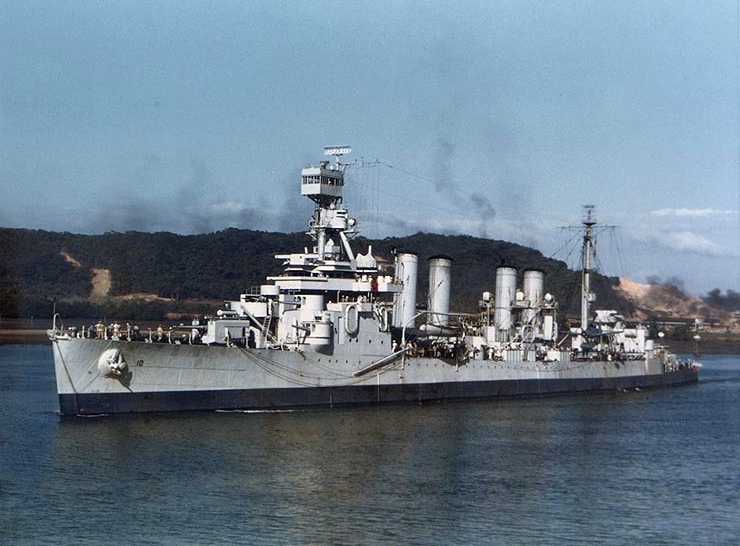
USS concord off Balboa, Panama, 1943
 USS Trenton
USS Trenton
in 1923, USS Trenton made shakedown cruise in the Mediterranean Sea, visiting Port Said, Egypt, Aden, Arabia, and Bushire, Persia. She sailed back to Villefranche, France and arrived at the Washington Navy Yard on 29 September 1924. The next year she was part of the Scouting Fleet off Guantánamo Bay, Cuba. She was later based at San Diego, operated in the Hawaiian Islands, and made exercises with the Cruiser Division 2, visiting Australia and New Zealand. She was back through the Galapagos, and Panama. In 1928 she carried Marines to Nicaragua.
She operated in the eastern Pacific until September 1934 and in 1936 evacuated US Citizen from Spanish threatened areas by the civil war. She also toured Central America, and South America, and returned to Australia in the winter of 1937 and 1938, but was in 1939 in the Mare island just constituted Battle Force. In 1940 she was in Europe, and carried to safety Luxembourg’s royal family.
From 1941 to mid-1944, USS Trenton served with the Southeast Pacific Force. She escorted convoys to Bora Bora in the Society Islands in 1942, and patrolled until 1944 the western coast of South America. She took part in the fall of 1944 to northern Kuril Islands operations and diversions for Leyte operations. Until decommission, she patrolled the waters off Alaska, the Aleutian Islands and the Kuril islands.
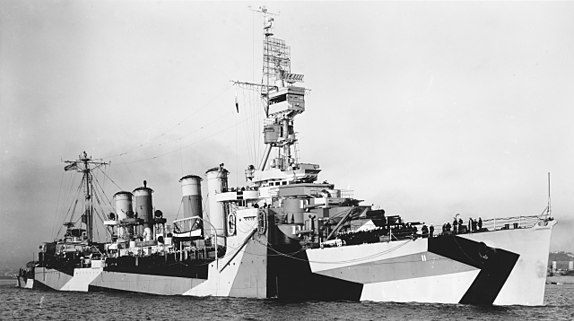
USS Trenton on San Francisco Bay 11 August 1944
 USS Marblehead
USS Marblehead
After the 1924 cruise to the English Channel and Mediterranean, USS Marblehead sailed to Australia in 1925, stopping in the Samoan, Society Islands and Galapagos. In 1927-28 she showed the flag off Nicaragua, and from Pearl Harbor, sailed with USS Richmond and Trenton to Shanghai, showing the flag during China’s civil war. Afterwards she operated with the Atlantic fleet from August 1928 to January 1933 and joined the Pacific fleet from February 1933 to January 1938. In 1939 she was sailing from Cavite (Philippine) to the Sea of Japan and South-East China seas, but in december 1941 she awaited instruction from Borneo.
She joined the Royal Netherlands Navy and the Royal Australian Navy protecting the Netherlands East Indies and took part in an attack of a combined US-Dutch force an IJN convoy off Balikpapan. She missed a convoy concentration at Kendari sailed to the Bunda Roads, but on 4 February she took part in the dreadful Battle of Makassar Strait. She dodged three attacks bt was struck by a fourth wave of seven bombers.
She took two direct hits and a third near-missed damaged her port bow, causing severe underwater flooding. She burned and listed to starboard, her rudder jammed, but she was able to steam at full speed to port. Her gunners defended her until the fires were under control. The attack left 15 dead and 84 seriously injured. She was provisionally repaired at Tjilatjap, and the ship was later decorated with the Navy Cross for her actions. She has repaired again in Trincomalee, Ceylon, the Durban and Port Elizabeth, and sailed back to New York, brooklyn NYd where she was overhauled and extensively repaired.
Afterward she sailed with the South Atlantic Force, patrolled the sea lanes from Recife and Bahia, Brazil, until February 1944. She then escorted convoys of the North Atlantic and sailed for the Mediterranean, based Palermo in July 1944, joining the task force of Operation Dragoon, for the southern France landings shelling enemy installations of Saint Raphael and afterward withdrew to Corsica. After sailing back home she participated in a summer training cruise for Naval Academy midshipmen and was decommissioned in 1945 in Philadelphia.
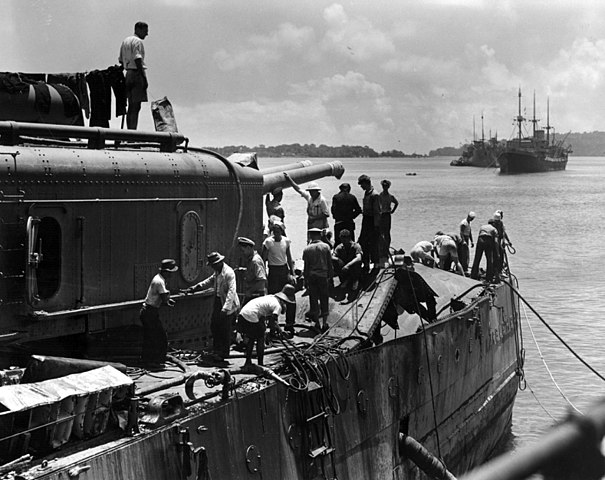
Bomb damage on the USS Marblehead following the Battle of Makassar strait in February 1942
 USS Memphis
USS Memphis
After a shakedown cruise in the Caribbean, she toured from Honolulu, Hawaii the South pacific, visiting Australia and New Zealand and was back home through the West Indies in 1926. The same year she toured Europe, visiting France and Spain. In 1927, USS Memphis carried Captain Charles A. Lindbergh and his plane at Southampton after his successful New York to Paris flight. She sailed back from Cherbourg, France and cruised the South Arlantic and West Indies. In 1932 she showed the flag off Nicaragua.
She then sailed to Australia in January 1938, and was back to San Francisco participating in a naval review, then departed for the Alaska where she was in April 1941. Back in home waters she took part in neutrality patrol between Trinidad–Cape San Roque–Cape Verde Islands, and escorted a convoy to Ascension Island. In January 1943, she carried President Franklin Delano Roosevelt’s for the Casablanca Conference, and later took part in search missions against blockade runners, off Bahia and Recife, Brazil.
She sailed for Europe (Naples, 16 January 1945), then Malta for the preliminary conferences before Yalta, then Algiers for the last conference and from then on participated in anniversary ceremonies of the Southern France Allied landings and Navy Day festivities at Naples. She was later back to Philadelphia to be stricken from the lists and sold to brokers.
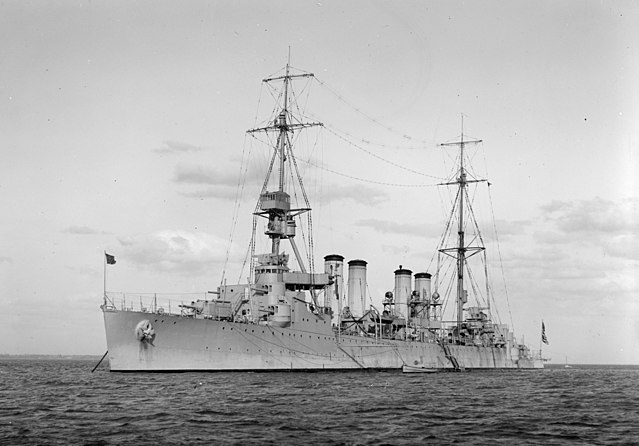
USS Memphis in Australian waters in its early appareance, 1925.
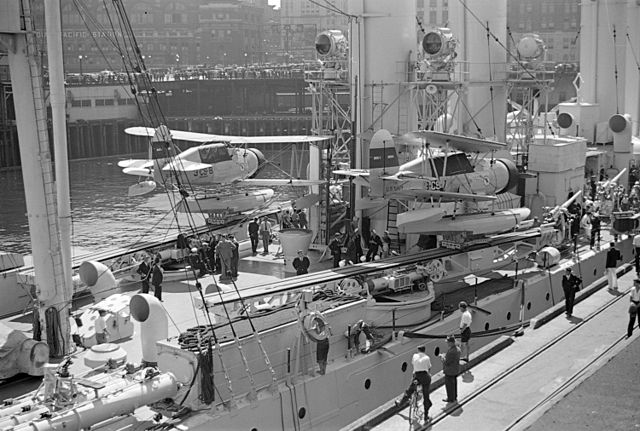
USS Cincinatti with visitors in Vancouver 1937
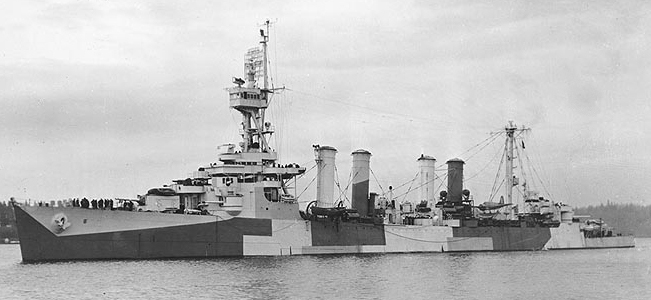
USS Detroit at Puget Sound April 1944

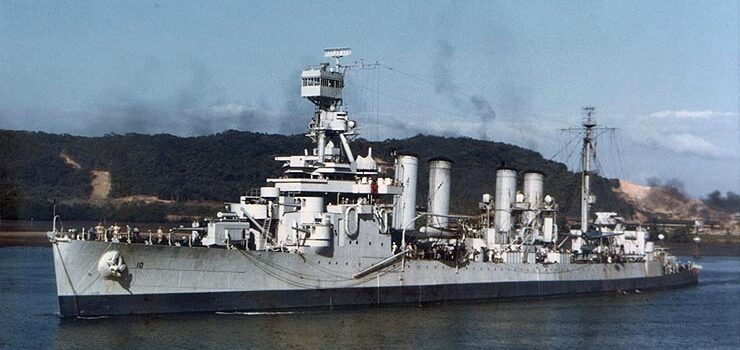
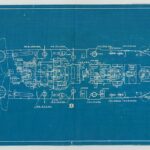
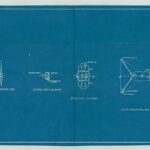
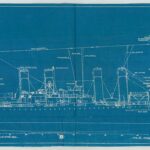
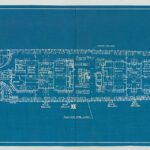
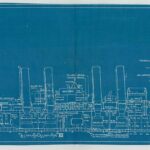
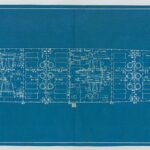
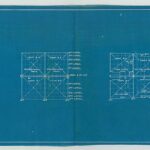
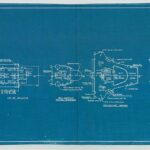
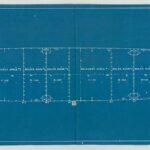
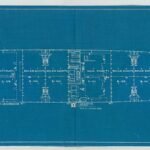
 Latest Facebook Entry -
Latest Facebook Entry -  X(Tweeter) Naval Encyclopedia's deck archive
X(Tweeter) Naval Encyclopedia's deck archive Instagram (@navalencyc)
Instagram (@navalencyc)





 French Navy
French Navy Royal Navy
Royal Navy Russian Navy
Russian Navy Armada Espanola
Armada Espanola Austrian Navy
Austrian Navy K.u.K. Kriegsmarine
K.u.K. Kriegsmarine Dansk Marine
Dansk Marine Nautiko Hellenon
Nautiko Hellenon Koninklije Marine 1870
Koninklije Marine 1870 Marinha do Brasil
Marinha do Brasil Osmanlı Donanması
Osmanlı Donanması Marina Do Peru
Marina Do Peru Marinha do Portugal
Marinha do Portugal Regia Marina 1870
Regia Marina 1870 Nihhon Kaigun 1870
Nihhon Kaigun 1870 Preußische Marine 1870
Preußische Marine 1870 Russkiy Flot 1870
Russkiy Flot 1870 Svenska marinen
Svenska marinen Søværnet
Søværnet Union Navy
Union Navy Confederate Navy
Confederate Navy Armada de Argentina
Armada de Argentina Imperial Chinese Navy
Imperial Chinese Navy Marinha do Portugal
Marinha do Portugal Mexico
Mexico Kaiserliche Marine
Kaiserliche Marine 1898 US Navy
1898 US Navy Sovietskiy Flot
Sovietskiy Flot Royal Canadian Navy
Royal Canadian Navy Royal Australian Navy
Royal Australian Navy RNZN Fleet
RNZN Fleet Chinese Navy 1937
Chinese Navy 1937 Kriegsmarine
Kriegsmarine Chilean Navy
Chilean Navy Danish Navy
Danish Navy Finnish Navy
Finnish Navy Hellenic Navy
Hellenic Navy Polish Navy
Polish Navy Romanian Navy
Romanian Navy Turkish Navy
Turkish Navy Royal Yugoslav Navy
Royal Yugoslav Navy Royal Thai Navy
Royal Thai Navy Minor Navies
Minor Navies Albania
Albania Austria
Austria Belgium
Belgium Columbia
Columbia Costa Rica
Costa Rica Cuba
Cuba Czechoslovakia
Czechoslovakia Dominican Republic
Dominican Republic Haiti
Haiti Hungary
Hungary Honduras
Honduras Estonia
Estonia Iceland
Iceland Eire
Eire Equador
Equador Iran
Iran Iraq
Iraq Latvia
Latvia Liberia
Liberia Lithuania
Lithuania Mandchukuo
Mandchukuo Morocco
Morocco Nicaragua
Nicaragua Persia
Persia San Salvador
San Salvador Sarawak
Sarawak Uruguay
Uruguay Venezuela
Venezuela Zanzibar
Zanzibar Warsaw Pact Navies
Warsaw Pact Navies Bulgaria
Bulgaria Hungary
Hungary

 Bundesmarine
Bundesmarine Dutch Navy
Dutch Navy Hellenic Navy
Hellenic Navy Marina Militare
Marina Militare Yugoslav Navy
Yugoslav Navy Chinese Navy
Chinese Navy Indian Navy
Indian Navy Indonesian Navy
Indonesian Navy JMSDF
JMSDF North Korean Navy
North Korean Navy Pakistani Navy
Pakistani Navy Philippines Navy
Philippines Navy ROKN
ROKN Rep. of Singapore Navy
Rep. of Singapore Navy Taiwanese Navy
Taiwanese Navy IDF Navy
IDF Navy Saudi Navy
Saudi Navy Royal New Zealand Navy
Royal New Zealand Navy Egyptian Navy
Egyptian Navy South African Navy
South African Navy






























 Ukrainian Navy
Ukrainian Navy dbodesign
dbodesign
Yes that is what I am saying in response to Michael Mitchell that the Omaha class Cruiser was a perfect example of his comment: “wonder when WG is going to add the US made Lend/Lease ships to the Russian lines? We did send them some Cruisers and destroyers after all. The Omaha class ship USS Milwaukee was lend leased to USSR, since this is already in- game it makes his question redundant, eg WG already has done what he is asking by including the Murmansk into the game about 2 years ago.
I would like to build a 1/300 model of the light cruiser Marblehead CL-12. I am looking for plans and drawings on which to base my model. Any suggestions?
Hi Bob
Sure !
https://www.history.navy.mil/research/histories/ship-histories/sources-of-ship-plans.html
https://floatingdrydock.com/TFW2.htm
Send me photos when it’s done !
One small notice, it’s written on start : “bearing the names of southern American cities (Omaha, Milwaukee, Cincinnati, Raleigh, Detroit, Richmond, Concord, Trenton, Marblehead, and Memphis).” It’s hardly to say , that Detroit or Milwaukee are “southern” cities. Detroit is on lake Erie, on north part of USA and Milwaukee is on lake Michigan, high North of USA and is not “southern city”, so would you, please, repair mistake and delete from text. Thank You
I amended this in “mostly”, thx.
It’s not even most of them.
Uh…Only three of the ten ships are named after southern cities: Raleigh, Richmond, and Memphis. That’s hardly “mostly”.
Are you from the U.S.? Have you considered having an actual editor take a look at this?
Well, that’s depend how you consider “southern”, if indeed these are under the maxon-dixon line… 🙂 But no, of course i’m not and i did not checked a map indeed. As for editors, some proposals but in the end, none really came on board.
Apparently the Omaha class were very uncomfortable – the designed complement of 330 was increased to 425, resulting in cramped accommodation and poor sanitary/hygiene provisions. Poor insulation meant that the class was hot when serving in the tropics and cold when serving in Arctic waters.